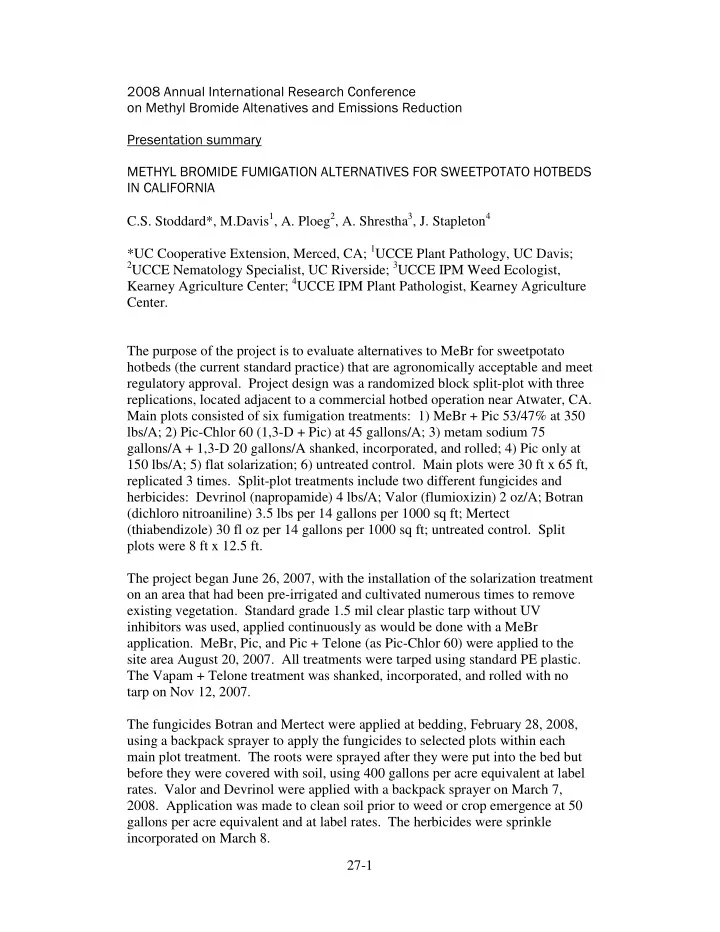

2008 Annual International Research Conference on Methyl Bromide Altenatives and Emissions Reduction Presentation summary METHYL BROMIDE FUMIGATION ALTERNATIVES FOR SWEETPOTATO HOTBEDS IN CALIFORNIA C.S. Stoddard*, M.Davis 1 , A. Ploeg 2 , A. Shrestha 3 , J. Stapleton 4 *UC Cooperative Extension, Merced, CA; 1 UCCE Plant Pathology, UC Davis; 2 UCCE Nematology Specialist, UC Riverside; 3 UCCE IPM Weed Ecologist, Kearney Agriculture Center; 4 UCCE IPM Plant Pathologist, Kearney Agriculture Center. The purpose of the project is to evaluate alternatives to MeBr for sweetpotato hotbeds (the current standard practice) that are agronomically acceptable and meet regulatory approval. Project design was a randomized block split-plot with three replications, located adjacent to a commercial hotbed operation near Atwater, CA. Main plots consisted of six fumigation treatments: 1) MeBr + Pic 53/47% at 350 lbs/A; 2) Pic-Chlor 60 (1,3-D + Pic) at 45 gallons/A; 3) metam sodium 75 gallons/A + 1,3-D 20 gallons/A shanked, incorporated, and rolled; 4) Pic only at 150 lbs/A; 5) flat solarization; 6) untreated control. Main plots were 30 ft x 65 ft, replicated 3 times. Split-plot treatments include two different fungicides and herbicides: Devrinol (napropamide) 4 lbs/A; Valor (flumioxizin) 2 oz/A; Botran (dichloro nitroaniline) 3.5 lbs per 14 gallons per 1000 sq ft; Mertect (thiabendizole) 30 fl oz per 14 gallons per 1000 sq ft; untreated control. Split plots were 8 ft x 12.5 ft. The project began June 26, 2007, with the installation of the solarization treatment on an area that had been pre-irrigated and cultivated numerous times to remove existing vegetation. Standard grade 1.5 mil clear plastic tarp without UV inhibitors was used, applied continuously as would be done with a MeBr application. MeBr, Pic, and Pic + Telone (as Pic-Chlor 60) were applied to the site area August 20, 2007. All treatments were tarped using standard PE plastic. The Vapam + Telone treatment was shanked, incorporated, and rolled with no tarp on Nov 12, 2007. The fungicides Botran and Mertect were applied at bedding, February 28, 2008, using a backpack sprayer to apply the fungicides to selected plots within each main plot treatment. The roots were sprayed after they were put into the bed but before they were covered with soil, using 400 gallons per acre equivalent at label rates. Valor and Devrinol were applied with a backpack sprayer on March 7, 2008. Application was made to clean soil prior to weed or crop emergence at 50 gallons per acre equivalent and at label rates. The herbicides were sprinkle incorporated on March 8. 27-1
A comprehensive nematode sampling of the main plot areas was performed on January 10, April 22, and May 13, 2008, with the last sampling corresponding to the harvest (cutting) of the sweetpotato plants. Root-knot nematodes ( Meloidogyne incognita and M. javanica ) can cause major damage to sweetpotatoes in the field, however, their impact in the hotbeds is not known. No root-knot nematodes were found in any of the treatments at any sampling date. The field site has a history of Methyl bromide fumigation, which may explain why no root-knot nematodes were found. The Telone+Vapam and the Methyl Bromide treatments had lower numbers of non-plant parasitic nematodes immediately after fumigation, but differences in non-plant-parasitic nematode levels largely disappeared later in the season. Fungicide and untreated split plots within each main plot area were soil sampled May 15, 2008, for Pythium counts. Inoculum density of Pythium spp. was determined by soil dilution plating onto a semi selective agar (corn meal agar amended with pimaricin and antibiotics). No significant differences were found between treatments. Pythium populations were low in all plots (in general, Pythium populations in most soils in the San Joaquin Valley average between 20 and 50 cfu/g). Weed population counts were taken on January 15, March 25, April 7, and April 22. Each weed within a treatment plot was counted by species and recorded on these dates. Hand weeding was done on April 7 with a 2-person crew. Time taken to weed each plot was recorded. The major weed species were puncturevine, henbit, groundcherry, cutleaf evening primrose, and fall panicum. The methyl bromide + Pic and the Telone (1,3-D) + Pic plots had significantly fewer weeds than the other treatments. Weed control was improved for the other fumigants, including solarization, when supplemented with the use of herbicides or hand weeding (Figure 1). Among the herbicides evaluated, Valor gave better weed control than Devrinol based on the weed spectrum present at this location. Some phytotoxicity on the sweetpotato plants was observed in the Valor treated plots, which resulted in delayed emergence and yellowing of the foliage. However, the final biomass of the plants was not affected at a 0.05 level of significance compared to the other treatments. Based on the first year of this study, weeds are the main pest problem that is controlled with fumigation in sweetpotato hotbeds. Several of the fumigation alternatives evaluated in this trial show promise as a workable replacement for MeBr, especially when combined with chemical herbicides. Refinements need to be made to the rates for both the Vapam + Telone and the Valor treatments to minimize crop phytotoxicity. Regulatory hurdles with the use of Telone remain. Further research is planned. 27-2
60 SOLARIZATION Control Devrinol Valor 50 No. of weeds/plot 40 30 20 10 0 April 7 April 22 March 25 Treatments Figure 1. Weed densities (# per m 2 ) in the solarization plots on March 25; April 7; and April 22, 2008. 27-3
Recommend
More recommend